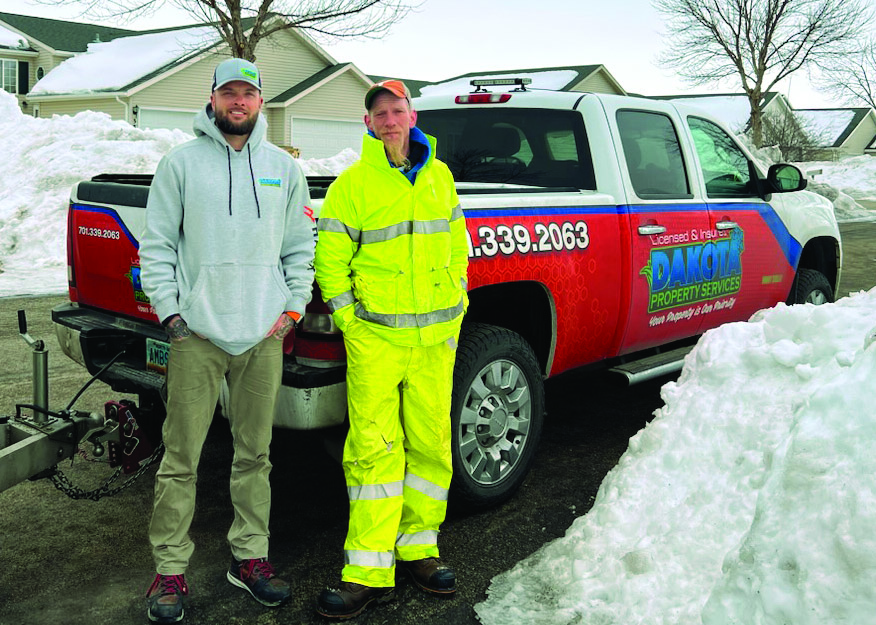
Dan Coleman and Joseph Berry of Dakota Property Services, along with four more team members, have been steaming ice dams every day for the past six weeks. (Photos/Tammy Finney.)
Nancy Edmonds Hanson
After March came in – and went out – like a lion, many Moorhead homeowners have been eyeing the edges of their roofs. This week’s heavy snow has only added to their worries.
The issue is ice dams. A thick, icy barrier has built up on many homes, most often on the north. The strengthening early-spring sun has generated melting beneath the layer of snow atop the shingles; but the colder-than-average nights that follow have frozen it in its tracks, forming that ridge along the eaves. Snowmelt pools behind the frozen barrier … sometimes forcing its way beneath the shingles and potentially inside the home.
The real villain, says longtime home inspector Dean Foell, lies deeper than sunshine. It’s hiding under the roof. “All the snow that’s collected up there has clogged a lot of attic vents, both turbines and the flat kind,” he explains. Then, as heat rises from inside the home and the sun begins to show more muscle, the lack of ventilation has been causing attics to heat up. The snow melts from the bottom, runs down the roof line and pools behind an ever-growing ice barrier in the gutters.
“We’ve seen plenty of old damage inside the homes we’ve inspected over the years,” the 20-year veteran inspector observes, “along with areas that have had to be repaired.” In extreme cases, ice dams outside translate to water dripping inside the home, soaking ceilings and walls with lingering damp spots that only fresh Sheetrock can cure.
Older homes – which tend to have less attic ventilation in the first place – are the most vulnerable, Foell says. Newer structures, though, are not immune. “It depends on whether they’ve been properly vented. And if vents have been allowed to be covered with snow, all bets are off.”
Dan Coleman has been fielding sometimes-panicked calls about ice dams every day for the past six weeks. His landscaping company, Dakota Property Services, has been steaming away countless ice dams over the past six weeks. He says this winter is the worst he’s run into since starting his business two years ago. “Guys who have been clearing roofs for 15 or 20 years longer than me are saying they’ve never seen anything like it,” he reports.
Coleman says stormy late-winter weather is the culprit that sets this year apart. “First we were loaded with heavy, wet snow. Then we’ve been going through these repeated thaw-and-freeze cycles. The problem is the heat that builds up when the roof vents are clogged,” he explains. “Your attic is supposed to be cold. If it’s not, you’ve got trouble.”
Foell says it’s not too late for homeowners to do what they can to ease the problem. “At this point, it’s still a good idea to try to remove whatever snow that you can safely reach,” he advises. “But you should have started that awhile back.” He does not recommend that residents try more drastic measures: “Don’t climb up there now and try to chip away the ice. It’s dangerous! On top of that, there’s a good chance you’ll damage the shingles.”
A better solution, he says, is to hire the professionals to steam open the gutters, allowing the meltwater to drain away. “We’ve almost reached the point where that’s all you can do to prevent more damage,” he emphasizes.
That’s the service provided by Coleman’s six-man crew and other landscaping companies like his. They use steam to gently thaw the ice dams, permitting melted snow to run safely through the gutter system. The labor-intensive process is a pricey one; costs run as much as $500 per hour, with many homes requiring three to four hours of work. Coleman, who describes himself as in recovery, has helped out a number of veterans by providing his services pro bono. He confides, “I try to live life with a purpose.”
As the area digs out from this week’s blizzard, both Foell and Coleman offer reminders that this, too, shall pass. Weather forecasts promise more spring-like temperatures in the week ahead. If that results in unwanted drips by doors and in entryways, Foell suggest homeowners avoid panic. “Watch for staining on the ceiling,” he advises. “If you see water dripping inside your home, poke a hole to let it out instead of letting the moisture build up in the attic. You can repair it after it dries out.”
Says Coleman, who does landscaping during the fairer seasons, this ice-bedeviled period is bound to end soon. “Hopefully, we’ll be switching gears in four weeks or so,” he predicts. “I’m an optimist.”


